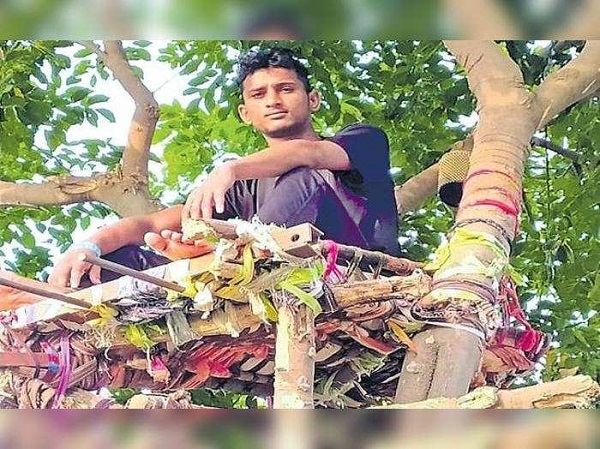Hyderabad, (Samajweekly) An 18-year-old youth in Telangana spent 11 days on a tree after testing positive for Covid-19 as he could not isolate himself in his small home.
Fearing that he might infect his parents and sister if he stays in the house, Ramawat Shiva Naik set up his own innovative ‘isolation facility’ on a tree near the house.
A resident of Kothanandikonda village in Adavidevulapally mandal of Nalgonda district, Shiva is an engineering student at college in Hyderabad. As the college was closed due to second wave of Covid-19 a few weeks ago, Shiva had returned home. To help his family, he started working as ‘hamali’ (porter) at a paddy procurement centre set up by the state government in the village to purchase paddy from farmers.
As he was suffering from fever and had other suspected symptoms of Covid-19, he underwent the test at a primary health centre (PHC) , located about five km from his village. He tested positive for Covid on May 4 but since he had mild symptoms, a health worker at PHC told him that there is no need for hospitalisation but advised him to isolate at home.
With four members of family sharing a one-room house with a single washroom, Shiva found that home isolation is not possible. With no government-run isolation facility in his village or in surrounding villages, the youth hit upon innovative idea.
“I had no other option. I did not want my family members to suffer because of me,” said Shiva.
Since he had learnt that Covid-infected people are suffering from low saturation level, he chose the tree for his isolation hoping that this will help him maintain good oxygen levels.
He selected a tree in front of his house as the isolation facility. The tree, which is called ‘Ganuga’ in Telugu (Pongame tree), is also said to have some medicinal properties.
Using bamboo sticks, ropes and few other items, he made a cot and tied it to the tree branches. Shiva’s parents used to keep his meals, water and other requirements in bucket and he used to pull up the same with a rope.
Shiva remained in touch with family and friends through his mobile phone, which also proved useful to kill the time. He sent a few messages calling up on local authorities to set up an isolation centre in the area.
Responding to his appeal and growing requests from people in his village and about a dozen other villages, the authorities set up an isolation centre late last week. They converted a hostel meant for students belonging to Scheduled Tribes into an isolation centre. They also persuaded Shiva to move to the centre. He will soon be completing his isolation period.
Shiva’s incident highlighted the problems faced by Covid infected in villages. Living in small houses with no or single washroom, they can’t isolate themselves.
In some instances, last year and also during the ongoing second wave, individuals who test positive were not allowed to enter into villages. At few places, Covid-infected patients are living in isolation either in huts outside the villages or in the fields.










